Nelly Pustelnik
DMS-Graph: Discrete Mumford-Shah on graph for mixing matrix estimation.

- Description: The discrete Mumford-Shah formalism has been introduced for the image denoising problem, allowing to capture both smooth behavior inside an object and sharp transitions on the boundary. In the present work, we propose first to extend this formalism to graphs and to the problem of mixing matrix estimation. New algorithmic schemes with convergence guarantees relying on proximal alternating minimization strategies are derived and their efficiency (good estimation and robustness to initialization) are evaluated on simulated data, in the context of vote transfer matrix estimation.
- Download: DMS_Graph_v1.0
- Associated journal paper: Y. Kaloga, M. Foare, N. Pustelnik, and P. Jensen , Discrete Mumford-Shah on graph for mixing matrix estimation, accepted in IEEE Signal Processing Letters, 2019. [PDF]
D-MS: Semi-linearized proximal alternating minimization for a discrete Mumford-Shah model.
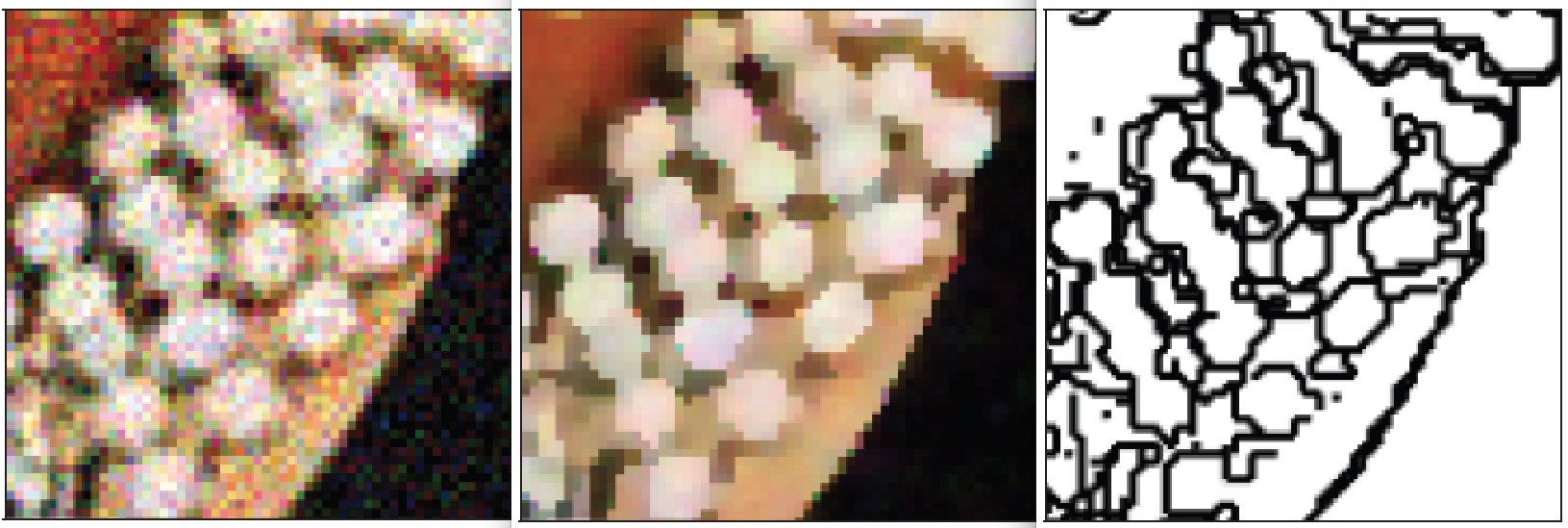
- Description: The Mumford-Shah model is a standard model in image segmentation and many approximations have been proposed in order to approximate it. The major interest of this functional is to be able to perform jointly image restoration and contour detection. In this work, we propose a general formulation of the discrete counterpart of the Mumford-Shah functional, adapted to nonsmooth penalizations, fitting the assumptions required by the Proximal Alternating Linearized Minimization (PALM), with convergence guarantees. A second contribution aims to relax some assumptions on the involved functionals and derive a novel Semi-Linearized Proximal Alternated Minimization (SL-PAM) algorithm, with proved convergence. We compare the performances of the algorithm with several nonsmooth penalizations, for Gaussian and Poisson denoising, image restoration and RGB-color denoising. We compare the results with state-of-the-art convex relaxations of the Mumford-Shah functional, and a discrete version of the Ambrosio-Tortorelli functional. We show that the SL-PAM algorithm is faster than the original PALM algorithm, and leads to competitive denoising, restoration and segmentation results.
- Download: DMS_v1.0
- Associated journal paper: M. Foare, N. Pustelnik, and L. Condat, Semi-linearized proximal alternating minimization for a discrete Mumford-Shah model, preprint, 2018 [PDF]
MPMS: Minimal Partition (Chan-Vese) with Minimal Proximal splitting scheme. Application to image segmentation and depth map disparity.
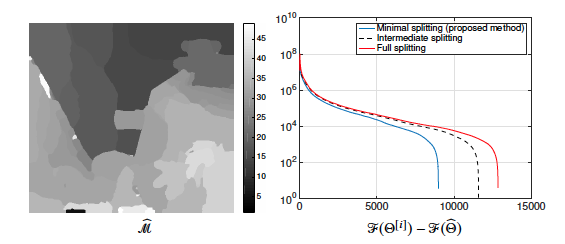
- Description: Proximal splitting algorithms for convex optimization are largely used in signal and image processing. They make possible to call the individual proximity operators of an arbitrary number of functions, whose sum is to be minimized. But the larger this number, the slower the convergence. In this work, we show how to compute the proximity operator of a sum of two functions, for a certain type of functions operating on objects having a graph structure. The gain provided by avoiding unnecessary splitting is illustrated by an application to image segmentation and depth map estimation.
- Download: MPMS_v1.0
- Associated journal paper: . Pustelnik, L. Condat, Proximity Operator of a Sum of Functions; Application to Depth Map Estimation, IEEE Signal Processing Letters, vol. 24, no. 12, pp. 1827 - 1831, Dec. 2017 [PDF]
PottsSelect: Selection of the regularization parameter in 1D Potts denoising problems
- Description: Piecewise constant denoising can be solved either by deterministic optimization approaches, based on the Potts model, or by stochastic Bayesian procedures. The former lead to low computational time but require the selection of a regularization parameter, whose value significantly impacts the achieved solution, and whose automated selection remains an involved and challenging problem. Conversely, fully Bayesian formalisms encapsulate the regularization parameter selection into hierarchical models, at the price of high computational costs. This contribution proposes an operational strategy that combines hierarchical Bayesian and Potts model formulations, with the double aim of automatically tuning the regularization parameter and of maintaining computational effciency. The proposed procedure relies on formally connecting a Bayesian framework to a l2-Potts functional. Behaviors and performance for the proposed piecewise constant denoising and regularization parameter tuning techniques are studied qualitatively and assessed quantitatively, and shown to compare favorably against those of a fully Bayesian hierarchical procedure, both in accuracy and in computational load.
- Download: toolbox_TVL0.zip (Matlab code developed by J. Frecon. Version: 28-July-2017)
- Associated journal paper: J. Frecon, N. Pustelnik, N. Dobigeon, H. Wendt, and P. Abry, Bayesian selection for the regularization parameter in TVl0 denoising problems, Accepted to IEEE Trans. on Signal Processing, 2017. [PDF]
SparseSVM: Sparse Support Vector Machine for Imbalanced Classes
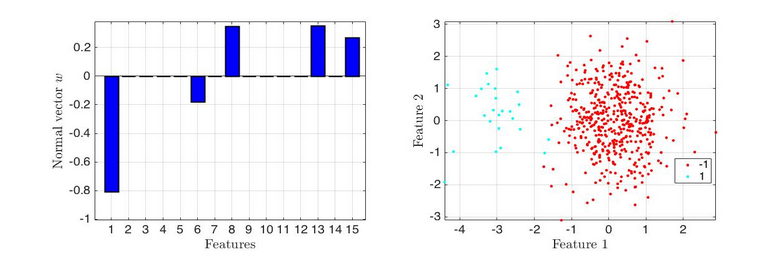
- Description: Fetal Heart Rate (FHR) monitoring is routinely used in clinical practice to help obstetricians assess fetal health status during delivery. However, early detection of fetal acidosis that allows relevant decisions for operative delivery remains a challenging task, receiving considerable attention. This contribution promotes Sparse Support Vector Machine (SVM) classification that permits to select a small number of relevant features and to achieve efficient fetal acidosis detection. A comprehensive set of features is used for FHR description, including enhanced and computerized clinical features, frequency domain, and scaling and multifractal features, all computed on a large (1288 subjects) and well documented database. The individual performance obtained for each feature independently is discussed first. Then, it is shown that the automatic selection of a sparse subset of features achieves satisfactory classification performance (sensitivity 0.73 and specificity 0.75, outperforming clinical practice). The subset of selected features (average depth of decelerations MADdtrd, baseline level 0, and variability H) receive simple interpretation in clinical practice. Intrapartum fetal acidosis detection is improved in several respects: A comprehensive set of features combining clinical, spectral and scale-free dynamics is used; an original multivariate classification targeting both sparse feature selection and high performance is devised; state-of-theart performance is obtained on a much larger database than that generally studied with description of comm
- Download: toolbox_sparseSVM.zip (Matlab code developed by J. Frecon. Version: 03-March-2017)
- Associated journal paper: J. Spilka, J. Frecon, R. Leonarduzzi, N. Pustelnik, P. Abry, M. Doret, Sparse Support Vector Machine for Intrapartum Fetal Heart Rate Classification, IEEE Journal of Biomedical and Health Informatics,vol. 21, no. 3, pp. 664 - 671, May 2017. [PDF]
AnalysisBivOfBmBB: Full Identification of Bivariate Operator Fractional Brownian Motion
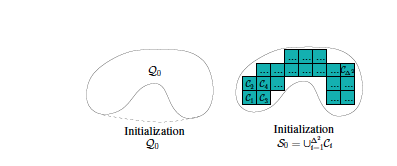
- Description: Self-similarity is widely considered the reference framework for modeling the scaling properties of real-world data. However, most theoretical studies and their practical use have remained univariate. Operator Fractional Brownian Motion (OfBm) was recently proposed as a multivariate model for self-similarity. Yet it has remained seldom used in applications because of serious issues that appear in the joint estimation of its numerous parameters. While the univariate fractional Brownian motion requires the estimation of two parameters only, its mere bivariate extension already involves 7 parameters which are very different in nature. The present contribution proposes a method for the full identification of bivariate OfBm (i.e., the joint estimation of all parameters) through an original formulation as a non-linear wavelet regression coupled with a custom-made Branch & Bound numerical scheme. The estimation performance (consistency and asymptotic normality) is mathematically established and numerically assessed by means of Monte Carlo experiments. The impact of the parameters defining OfBm on the estimation performance as well as the associated computational costs are also thoroughly investigated.
- Download: toolbox_analysisBivOfBmBB.zip (Matlab code developed by J. Frecon. Version: 03-March-2017)
- Associated journal paper: J. Frecon, G. Didier, N. Pustelnik, and P. Abry, Non-Linear Wavelet Regression and Branch and Bound Optimization for the Full Identification of Bivariate Operator Fractional Brownian Motion, IEEE Trans. on Signal Processing, vol. 64, no. 15, pp. 4040 - 4049, Aug. 2016. [PDF]
TV_OnTheFly: On-the-fly Approximation of Multivariate Total Variation Minimization
- Description: In the context of change-point detection, addressed by Total Variation minimization strategies, an efficient on-the-fly algorithm has been designed leading to exact solutions for univariate data. In this contribution, an extension of such an on-the-fly strategy to multivariate data is investigated. The proposed algorithm relies on the local validation of the Karush-Kuhn-Tucker conditions on the dual problem. Showing that the non-local nature of the multivariate setting precludes to obtain an exact on-the-fly solution, we devise an on-the-fly algorithm delivering an approximate solution, whose quality is controlled by a practitioner-tunable parameter, acting as a trade-off between quality and computational cost. Performance assessment shows that high quality solutions are obtained on-the-fly while benefiting of computational costs several orders of magnitude lower than standard iterative procedures. The proposed algorithm thus provides practitioners with an efficient multivariate change-point detection on-the-fly procedure.
- Download: toolbox_TV_OnTheFly.zip (Matlab code developed by J. Frecon. Version: 03-November-2016)
- Associated journal paper: J. Frecon, N. Pustelnik, P. Abry, and L. Condat, On-The-Fly Approximation of Multivariate Total Variation Minimization, IEEE Trans. on Signal Processing, vol. 64, no. 9, pp. 2355 - 2364, May 2016. [PDF]
2D Prony-Huang Transform : spectral analysis of an image combining EMD decomposition and local Prony spectral estimation

- Description: This work proposes an extension of the 1-D Hilbert Huang transform for the analysis of images. The proposed method consists in (i) adaptively decomposing an image into oscillating parts called intrinsic mode functions (IMFs) using a mode decomposition procedure, and (ii) providing a local spectral analysis of the obtained IMFs in order to get the local amplitudes, frequencies, and orientations. For the decomposition step, we propose two robust 2-D mode decompositions based on non-smooth convex optimization: a "Genuine 2-D" approach, that constrains the local extrema of the IMFs, and a "Pseudo 2-D" approach, which constrains separately the extrema of lines, columns, and diagonals. The spectral analysis step is based on Prony annihilation property that is applied on small square patches of the IMFs. This toolbox provides both the proposed proximal EMD-2D decomposition procedure and the PHT procedure, which combines EMD-2D decomposition and spectral analysis.
- Download: Toolbox_PHT_2D_v-1.0.zip (Matlab code developed by J. Schmitt)
- Associated journal paper: J. Schmitt, N. Pustelnik, P. Borgnat, P. Flandrin, and L. Condat, A 2-D Prony-Huang Transform: A New Tool for 2-D Spectral Analysis, IEEE Trans. Image processing, vol. 23, no. 12, pp. 5531--5544, Oct. 2014. [PDF]
Multicomponent image restoration (color imagery, hyperspectral imagery, ...)
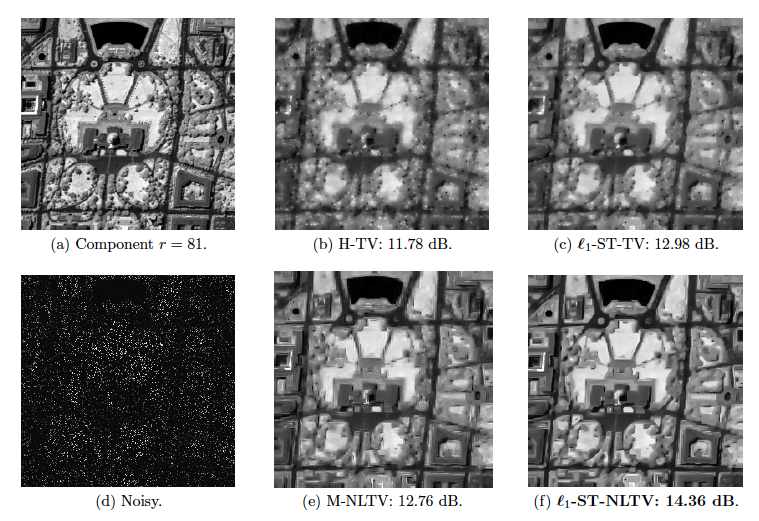
- Description: Non-Local Total Variation (NLTV) has emerged as a useful tool in variational methods for image recovery problems. In this toolbox, we extend the NLTV-based regularization to multicomponent images by taking advantage of the Structure Tensor (ST) resulting from the gradient of a multicomponent image. The proposed approach allows us to penalize the non-local variations, jointly for the different components, through various matrix norms. To facilitate the choice of the hyper-parameters, we adopt a constrained convex optimization approach in which we minimize the data fidelity term subject to a constraint involving the ST-NLTV regularization. The resulting convex optimization problem is solved with a novel epigraphical projection method. This formulation can be efficiently implemented thanks to the flexibility offered by recent primal-dual proximal algorithms. Two demo files are provided. One for color imagery restoration ("example_color.m") and one for hypersectral restoration ("example_hyperpsectral.m"). The figure above compares the results with several state-of-the-art strategies (b,c,e) and with the proposed ST-NLTV.
- Download: Toolbox_MultiResto_v-1.0.zip (Matlab code developed by G. Chierchia)
- Associated journal paper: G. Chierchia, N. Pustelnik, B. Pesquet-Popescu, J.-C. Pesquet, A Non-Local Structure Tensor Based Approach for Multicomponent Image Recovery Problems, IEEE Trans. Image processing, vol. 23, no. 12, pp. 5233--5248, Oct. 2014. [PDF]
Signal mode decomposition


- Description: This toolbox provides a decomposition of signal into a trend and its intrinsic mode functions (IMF). The proposed algorithm is an alternative solution for the usual Empirical Mode Decomposition by considering optimization tools rather than the empirical sifting procedure involved in EMD. The proposed method is called Prox-EMD.
- Download: Prox-EMD_v1.0.zip
- Associated journal paper: N. Pustelnik, P. Borgnat, P. Flandrin, Empirical Mode Decomposition revisited by multicomponent non smooth convex optimization, Signal Processing, Vol. 102, pp. 313--331, Sept. 2014. [PDF]
Image restoration toolbox
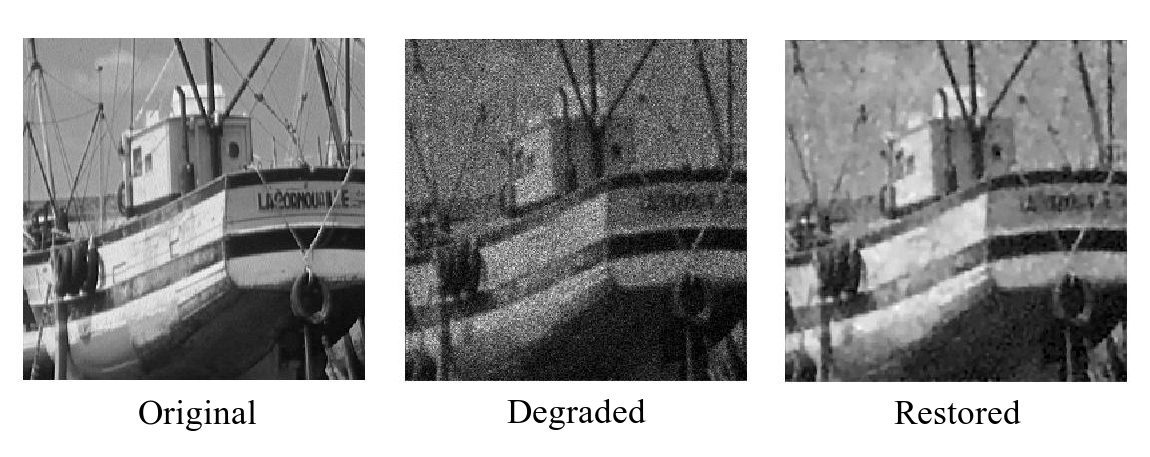
- Description: This toolbox allows to restore an image degraded by a convolution operator and a noise (Gaussian or Poisson). The regularization term can be :
- a l1 norm applied to DTT coefficients
- a total variation term
- an hybrid regularization composed with the l1 norm and TV.
- Download: RestoPPXA_Lab_v2.0.zip
- Fiche PLUME
Image decomposition toolbox
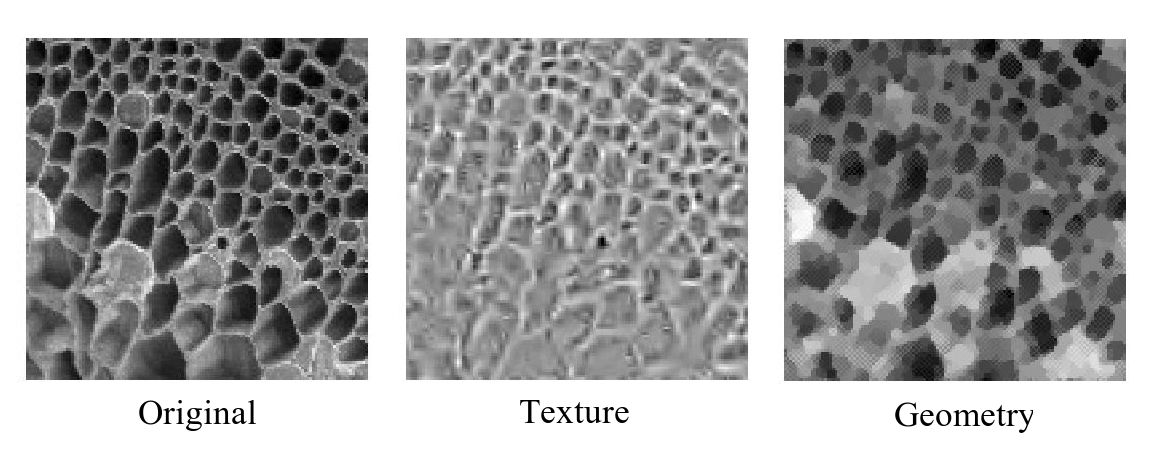
- Description: This toolbox allows to decompose an image, degraded by a convolution operator and Poisson noise, into geometric and texture components. The considered criterion is composed with a Kullback-Leibler divergence as data fidelity term, an indicator function allowing to constraint the dynamic range of the sum of geometric and texture components, a l1 norm applied on the DTT (Dual-Tree Transform) texture coefficients and a total variation term to penalize the geometric component. The restoration process uses the Parallel ProXimal Algorithm.
The sum of the geometric and texture components allows to obtain a restored image. In this toolbox a program allows to fairly compare the restoration results between the decomposition approach and a monocomponent variational approach considering l1 norm and TV applied on the image.
- Download : TexGeoPPXA_Lab_v1.0.tar.gz
- Fiche PLUME

